Xiaokang Zhang
Geospatial Foundation Models to Enable Progress on Sustainable Development Goals
May 30, 2025Abstract:Foundation Models (FMs) are large-scale, pre-trained AI systems that have revolutionized natural language processing and computer vision, and are now advancing geospatial analysis and Earth Observation (EO). They promise improved generalization across tasks, scalability, and efficient adaptation with minimal labeled data. However, despite the rapid proliferation of geospatial FMs, their real-world utility and alignment with global sustainability goals remain underexplored. We introduce SustainFM, a comprehensive benchmarking framework grounded in the 17 Sustainable Development Goals with extremely diverse tasks ranging from asset wealth prediction to environmental hazard detection. This study provides a rigorous, interdisciplinary assessment of geospatial FMs and offers critical insights into their role in attaining sustainability goals. Our findings show: (1) While not universally superior, FMs often outperform traditional approaches across diverse tasks and datasets. (2) Evaluating FMs should go beyond accuracy to include transferability, generalization, and energy efficiency as key criteria for their responsible use. (3) FMs enable scalable, SDG-grounded solutions, offering broad utility for tackling complex sustainability challenges. Critically, we advocate for a paradigm shift from model-centric development to impact-driven deployment, and emphasize metrics such as energy efficiency, robustness to domain shifts, and ethical considerations.
CADFormer: Fine-Grained Cross-modal Alignment and Decoding Transformer for Referring Remote Sensing Image Segmentation
Mar 30, 2025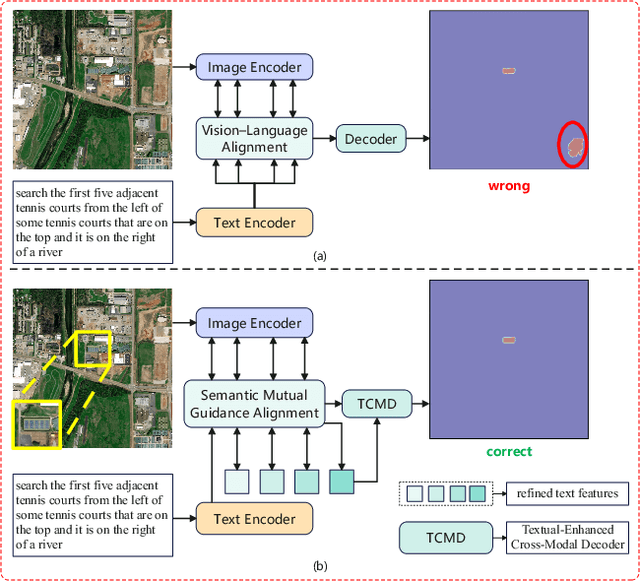
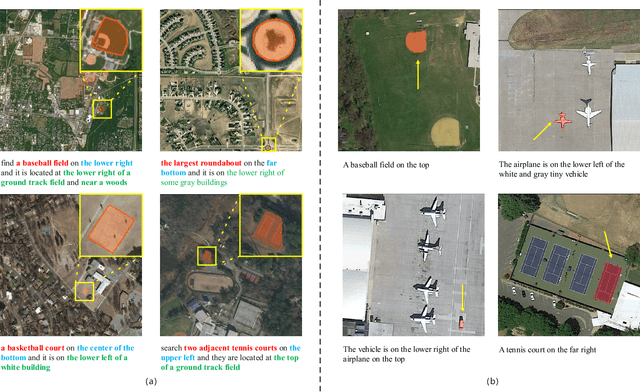
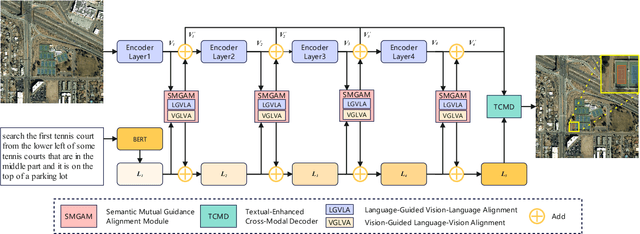
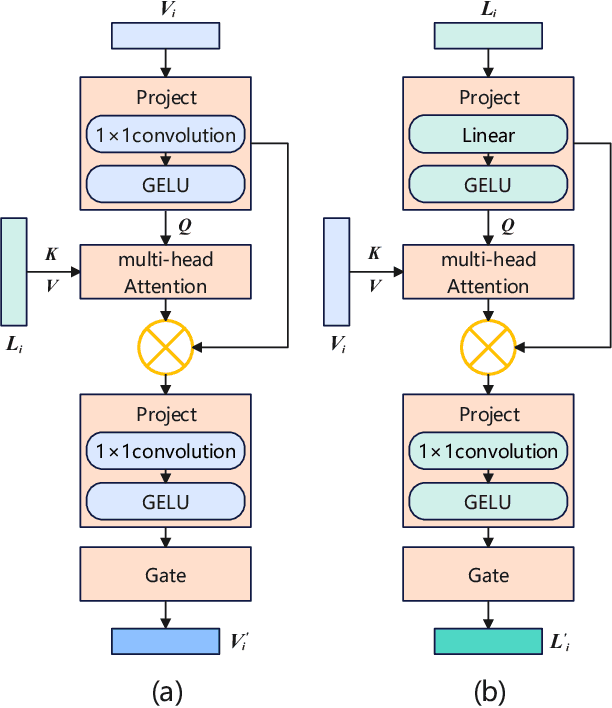
Abstract:Referring Remote Sensing Image Segmentation (RRSIS) is a challenging task, aiming to segment specific target objects in remote sensing (RS) images based on a given language expression. Existing RRSIS methods typically employ coarse-grained unidirectional alignment approaches to obtain multimodal features, and they often overlook the critical role of language features as contextual information during the decoding process. Consequently, these methods exhibit weak object-level correspondence between visual and language features, leading to incomplete or erroneous predicted masks, especially when handling complex expressions and intricate RS image scenes. To address these challenges, we propose a fine-grained cross-modal alignment and decoding Transformer, CADFormer, for RRSIS. Specifically, we design a semantic mutual guidance alignment module (SMGAM) to achieve both vision-to-language and language-to-vision alignment, enabling comprehensive integration of visual and textual features for fine-grained cross-modal alignment. Furthermore, a textual-enhanced cross-modal decoder (TCMD) is introduced to incorporate language features during decoding, using refined textual information as context to enhance the relationship between cross-modal features. To thoroughly evaluate the performance of CADFormer, especially for inconspicuous targets in complex scenes, we constructed a new RRSIS dataset, called RRSIS-HR, which includes larger high-resolution RS image patches and semantically richer language expressions. Extensive experiments on the RRSIS-HR dataset and the popular RRSIS-D dataset demonstrate the effectiveness and superiority of CADFormer. Datasets and source codes will be available at https://github.com/zxk688.
Semantic-Spatial Feature Fusion with Dynamic Graph Refinement for Remote Sensing Image Captioning
Mar 30, 2025



Abstract:Remote sensing image captioning aims to generate semantically accurate descriptions that are closely linked to the visual features of remote sensing images. Existing approaches typically emphasize fine-grained extraction of visual features and capturing global information. However, they often overlook the complementary role of textual information in enhancing visual semantics and face challenges in precisely locating objects that are most relevant to the image context. To address these challenges, this paper presents a semantic-spatial feature fusion with dynamic graph refinement (SFDR) method, which integrates the semantic-spatial feature fusion (SSFF) and dynamic graph feature refinement (DGFR) modules. The SSFF module utilizes a multi-level feature representation strategy by leveraging pre-trained CLIP features, grid features, and ROI features to integrate rich semantic and spatial information. In the DGFR module, a graph attention network captures the relationships between feature nodes, while a dynamic weighting mechanism prioritizes objects that are most relevant to the current scene and suppresses less significant ones. Therefore, the proposed SFDR method significantly enhances the quality of the generated descriptions. Experimental results on three benchmark datasets demonstrate the effectiveness of the proposed method. The source code will be available at https://github.com/zxk688}{https://github.com/zxk688.
OmniSQL: Synthesizing High-quality Text-to-SQL Data at Scale
Mar 04, 2025Abstract:Text-to-SQL, the task of translating natural language questions into SQL queries, plays a crucial role in enabling non-experts to interact with databases. While recent advancements in large language models (LLMs) have significantly enhanced text-to-SQL performance, existing approaches face notable limitations in real-world text-to-SQL applications. Prompting-based methods often depend on closed-source LLMs, which are expensive, raise privacy concerns, and lack customization. Fine-tuning-based methods, on the other hand, suffer from poor generalizability due to the limited coverage of publicly available training data. To overcome these challenges, we propose a novel and scalable text-to-SQL data synthesis framework for automatically synthesizing large-scale, high-quality, and diverse datasets without extensive human intervention. Using this framework, we introduce SynSQL-2.5M, the first million-scale text-to-SQL dataset, containing 2.5 million samples spanning over 16,000 synthetic databases. Each sample includes a database, SQL query, natural language question, and chain-of-thought (CoT) solution. Leveraging SynSQL-2.5M, we develop OmniSQL, a powerful open-source text-to-SQL model available in three sizes: 7B, 14B, and 32B. Extensive evaluations across nine datasets demonstrate that OmniSQL achieves state-of-the-art performance, matching or surpassing leading closed-source and open-source LLMs, including GPT-4o and DeepSeek-V3, despite its smaller size. We release all code, datasets, and models to support further research.
Uncovering the Impact of Chain-of-Thought Reasoning for Direct Preference Optimization: Lessons from Text-to-SQL
Feb 17, 2025



Abstract:Direct Preference Optimization (DPO) has proven effective in complex reasoning tasks like math word problems and code generation. However, when applied to Text-to-SQL datasets, it often fails to improve performance and can even degrade it. Our investigation reveals the root cause: unlike math and code tasks, which naturally integrate Chain-of-Thought (CoT) reasoning with DPO, Text-to-SQL datasets typically include only final answers (gold SQL queries) without detailed CoT solutions. By augmenting Text-to-SQL datasets with synthetic CoT solutions, we achieve, for the first time, consistent and significant performance improvements using DPO. Our analysis shows that CoT reasoning is crucial for unlocking DPO's potential, as it mitigates reward hacking, strengthens discriminative capabilities, and improves scalability. These findings offer valuable insights for building more robust Text-to-SQL models. To support further research, we publicly release the code and CoT-enhanced datasets.
Kolmogorov-Arnold Network for Remote Sensing Image Semantic Segmentation
Jan 13, 2025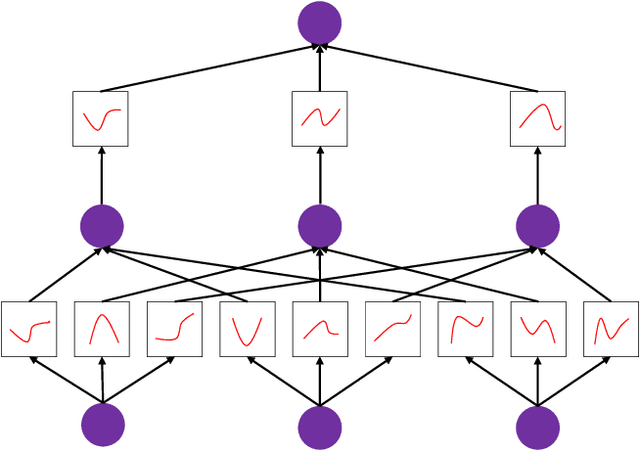


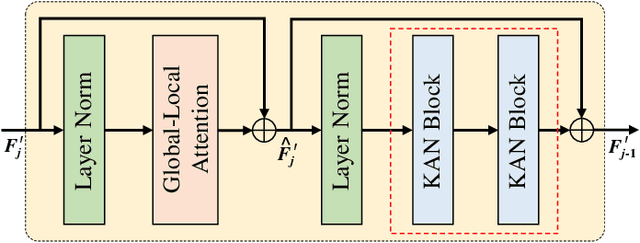
Abstract:Semantic segmentation plays a crucial role in remote sensing applications, where the accurate extraction and representation of features are essential for high-quality results. Despite the widespread use of encoder-decoder architectures, existing methods often struggle with fully utilizing the high-dimensional features extracted by the encoder and efficiently recovering detailed information during decoding. To address these problems, we propose a novel semantic segmentation network, namely DeepKANSeg, including two key innovations based on the emerging Kolmogorov Arnold Network (KAN). Notably, the advantage of KAN lies in its ability to decompose high-dimensional complex functions into univariate transformations, enabling efficient and flexible representation of intricate relationships in data. First, we introduce a KAN-based deep feature refinement module, namely DeepKAN to effectively capture complex spatial and rich semantic relationships from high-dimensional features. Second, we replace the traditional multi-layer perceptron (MLP) layers in the global-local combined decoder with KAN-based linear layers, namely GLKAN. This module enhances the decoder's ability to capture fine-grained details during decoding. To evaluate the effectiveness of the proposed method, experiments are conducted on two well-known fine-resolution remote sensing benchmark datasets, namely ISPRS Vaihingen and ISPRS Potsdam. The results demonstrate that the KAN-enhanced segmentation model achieves superior performance in terms of accuracy compared to state-of-the-art methods. They highlight the potential of KANs as a powerful alternative to traditional architectures in semantic segmentation tasks. Moreover, the explicit univariate decomposition provides improved interpretability, which is particularly beneficial for applications requiring explainable learning in remote sensing.
CoT-based Synthesizer: Enhancing LLM Performance through Answer Synthesis
Jan 03, 2025



Abstract:Current inference scaling methods, such as Self-consistency and Best-of-N, have proven effective in improving the accuracy of LLMs on complex reasoning tasks. However, these methods rely heavily on the quality of candidate responses and are unable to produce correct answers when all candidates are incorrect. In this paper, we propose a novel inference scaling strategy, CoT-based Synthesizer, which leverages CoT reasoning to synthesize superior answers by analyzing complementary information from multiple candidate responses, even when all candidate responses are flawed. To enable a lightweight and cost-effective implementation, we introduce an automated data generation pipeline that creates diverse training data. This allows smaller LLMs trained on this data to improve the inference accuracy of larger models, including API-based LLMs. Experimental results across four benchmark datasets with seven policy models demonstrate that our method significantly enhances performance, with gains of 11.8% for Llama3-8B and 10.3% for GPT-4o on the MATH dataset. The corresponding training data and code are publicly available on https://github.com/RUCKBReasoning/CoT-based-Synthesizer.
Dynamic Scaling of Unit Tests for Code Reward Modeling
Jan 02, 2025



Abstract:Current large language models (LLMs) often struggle to produce accurate responses on the first attempt for complex reasoning tasks like code generation. Prior research tackles this challenge by generating multiple candidate solutions and validating them with LLM-generated unit tests. The execution results of unit tests serve as reward signals to identify correct solutions. As LLMs always confidently make mistakes, these unit tests are not reliable, thereby diminishing the quality of reward signals. Motivated by the observation that scaling the number of solutions improves LLM performance, we explore the impact of scaling unit tests to enhance reward signal quality. Our pioneer experiment reveals a positive correlation between the number of unit tests and reward signal quality, with greater benefits observed in more challenging problems. Based on these insights, we propose CodeRM-8B, a lightweight yet effective unit test generator that enables efficient and high-quality unit test scaling. Additionally, we implement a dynamic scaling mechanism that adapts the number of unit tests based on problem difficulty, further improving efficiency. Experimental results show that our approach significantly improves performance across various models on three benchmarks (e.g., with gains of 18.43% for Llama3-8B and 3.42% for GPT-4o-mini on HumanEval Plus).
DeepSeek-V3 Technical Report
Dec 27, 2024



Abstract:We present DeepSeek-V3, a strong Mixture-of-Experts (MoE) language model with 671B total parameters with 37B activated for each token. To achieve efficient inference and cost-effective training, DeepSeek-V3 adopts Multi-head Latent Attention (MLA) and DeepSeekMoE architectures, which were thoroughly validated in DeepSeek-V2. Furthermore, DeepSeek-V3 pioneers an auxiliary-loss-free strategy for load balancing and sets a multi-token prediction training objective for stronger performance. We pre-train DeepSeek-V3 on 14.8 trillion diverse and high-quality tokens, followed by Supervised Fine-Tuning and Reinforcement Learning stages to fully harness its capabilities. Comprehensive evaluations reveal that DeepSeek-V3 outperforms other open-source models and achieves performance comparable to leading closed-source models. Despite its excellent performance, DeepSeek-V3 requires only 2.788M H800 GPU hours for its full training. In addition, its training process is remarkably stable. Throughout the entire training process, we did not experience any irrecoverable loss spikes or perform any rollbacks. The model checkpoints are available at https://github.com/deepseek-ai/DeepSeek-V3.
Scaling Law for Post-training after Model Pruning
Nov 15, 2024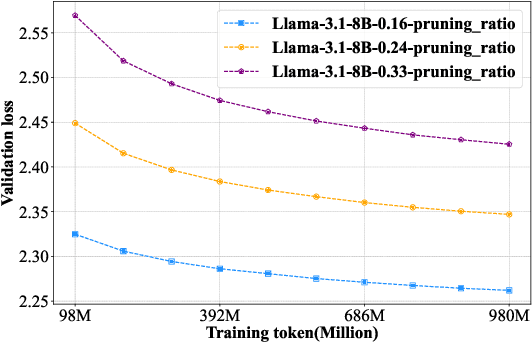
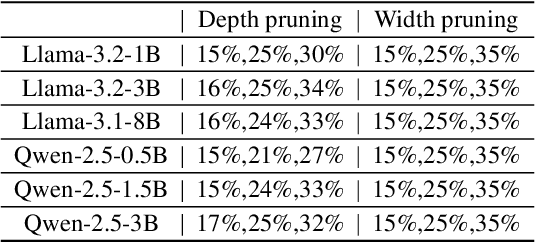
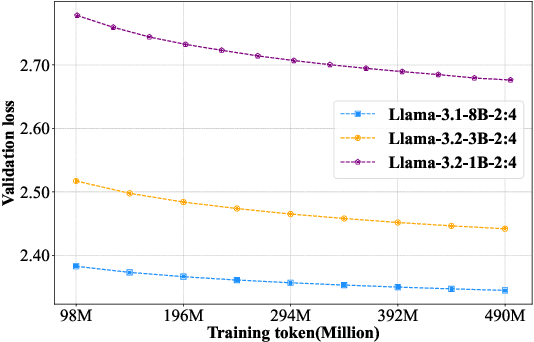
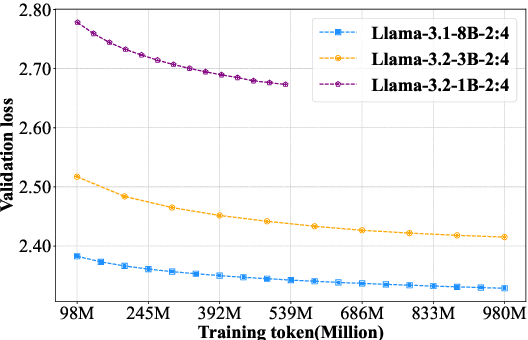
Abstract:Large language models (LLMs) based on the Transformer architecture are widely employed across various domains and tasks. However, their increasing size imposes significant hardware demands, limiting practical deployment. To mitigate this, model pruning techniques have been developed to create more efficient models while maintaining high performance. Despite this, post-training after pruning is crucial for performance recovery and can be resource-intensive. This paper investigates the post-training requirements of pruned LLMs and introduces a scaling law to determine the optimal amount of post-training data. Post-training experiments with the Llama-3 and Qwen-2.5 series models, pruned using depth pruning, width pruning, and 2:4 semi-structured pruning, show that higher pruning ratios necessitate more post-training data for performance recovery, whereas larger LLMs require less. The proposed scaling law predicts a model's loss based on its parameter counts before and after pruning, as well as the post-training token counts. Furthermore, we find that the scaling law established from smaller LLMs can be reliably extrapolated to larger LLMs. This work provides valuable insights into the post-training of pruned LLMs and offers a practical scaling law for optimizing post-training data usage.
 Add to Chrome
Add to Chrome Add to Firefox
Add to Firefox Add to Edge
Add to Edge